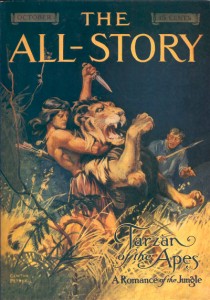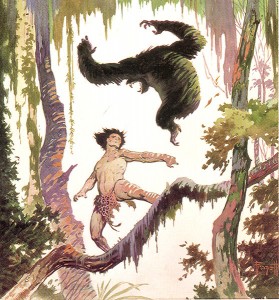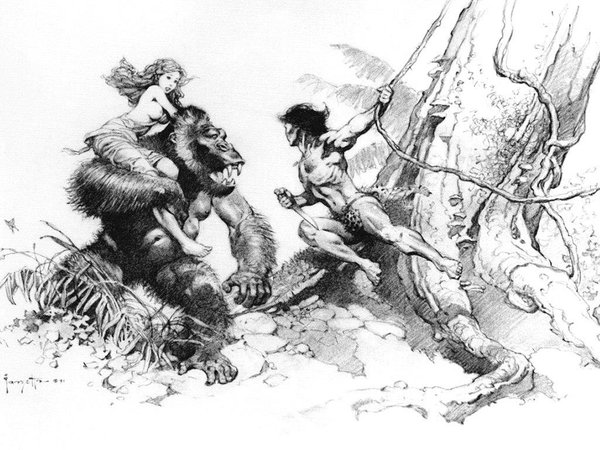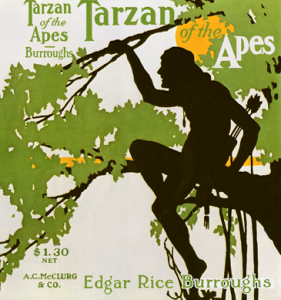 Stories of humans being raised by animals dates as far back as 5th
Century BC with Romulus and Remus who were suckled by a she-wolf before
founding Rome, and of course in the 1800s Rudyard Kipling wrote many
short stories about young Mowgli who was also raised by wolves, but it
wasn’t until 1912, in the pages of All-Story Magazine, did the world get one of the greatest heroes to ever grace the printed page, Tarzan of the Apes.
Stories of humans being raised by animals dates as far back as 5th
Century BC with Romulus and Remus who were suckled by a she-wolf before
founding Rome, and of course in the 1800s Rudyard Kipling wrote many
short stories about young Mowgli who was also raised by wolves, but it
wasn’t until 1912, in the pages of All-Story Magazine, did the world get one of the greatest heroes to ever grace the printed page, Tarzan of the Apes.There have been Many Faces of Tarzan since Edgar Rice Burroughs published his first installment back in 1912; from the silent screen with Elmo Lincoln to Johnny Weissmuller for MGM, and for decades to follow many more men donned the traditional loincloth of Tarzan, but today we will look at the original story that started it all.
Like many books by Edgar Rice Burroughs this story begins with a narrator explaining how he came across this incredible account, a story of how an English Lord by the name of John Clayton, Lord Greystoke and his wife Lady Alice were marooned on the savage coast of Africa by a group of mutineers. The reason for their marooning, opposed to being straight up murdered by the mutineers, is because John Clayton had saved the life of the head mutineer earlier during the voyage. This is an important lesson for all of us because any good deed could someday save your life…or at least land you alive on a godforsaken coastline where almost every creature is bent on your destruction. So take from that what you will.
With supplies left to them by the mutineers Clayton is able to build a nice cabin for his wife and soon to be born child, and a short time late the cry of a little baby joins the cacophony of cries from the jungle. The Claytons have much to deal with when it comes to unwanted callers and the worst of this is the Great Apes of the tribe of Kerchak, and only Clayton’s “thunder stick” keeps these brutes at bay. After one particular traumatic encounter with the apes where, Alice is forced to shoot one, her mind to snaps and from that day on she lived believing they were back in London. That is until one morning, when the bay was but a year old, John found his beloved Alice dead. She had gone peacefully in her sleep. A distraught Clayton forgets to secure the cabin door and soon finds himself unarmed and facing the ferocious Kerchak. Things go poorly for Lord Greystoke. The baby on the other hand has a lucky reprieve as the she-ape Kala prevents Kerchak from killing the tiny lordling. Earlier Kala’s own baby was killed when an enraged Kerchak chased her through treetops, the little baby ape was unable to hold on to it's mother and fell to its death. Seeing a chance to replace a dead child for a living one she makes the swap.
Burroughs goes into quite a bit of detail on how a human child could possibly survive being raised in the hostile jungle. Of course there is pretty much no chance something like this could happen in the real world, but in the pulp adventure world of Edgar Rice Burroughs it makes perfect sense. Much of what makes it work stems from the dynamic between young child, now named Tarzan (ape for white-skin), and his mother Kala. These apes are kind of a missing link, and have almost a society of their own with laws and rituals, so the she-ape Kala is shown as being a being of deep love, and it is her unbridled love for this weak pale thing that keeps Tarzan alive. When all of Tarzan’s contemporaries have reached full adult size in a few years poor three year old Tarzan is still having a difficult time walking through the jungle let alone climb the massive trees that make up his world. It was up to Kala to prevent Kerchak and the other apes from killing this pathetic thing. But it’s not just Kala’s loving protective nature that allows Tarzan to survive in this world of sudden death, but Tarzan’s innate intelligence.
Eventually Tarzan finds the cabin built by his father and in it he discovers two important things; the books that were brought to help teach the new Greystoke baby, and John Clayton’s hunting knife. One stokes and expands the little jungle boy’s mind while the other gives him a fighting chance against creatures with fangs and claws. Two physical features Tarzan quite lacks. Right off the bat the knife saves his life when he encounters a gorilla, one of the more dangerous enemies of the Great Apes, and it is only the use of the knife, mostly by accident, that allows Tarzan to survive this meeting. He also creates ropes to lasso his prey, or his annoying foster father who would really like to see Tarzan dead, and gives him the edge even against such dangerous adversaries as Sabor the lioness. When a group of cannibals move into the territory Tarzan is able to acquire, through some killing and theft, a bow and poison tipped arrows. The downside to these new neighbours is that one of them kills Tarzan’s beloved Kala. The enraged ape man tracks down the “murderer” and kills the bastard.
Burroughs depicts Tarzan as a being who thrills in the kill, but without any malice of the heart. We are told that some of Tarzan genetic heritage keeps him on the straight and narrow; such as when after killing the cannibal that murdered his mother he does not eat him. At first Tarzan is perplexed by his resistance to eating this black man, as he is clearly not quite the same as Tarzan, but still he cannot eat him as he would any other prey. In many of his books Burroughs delves into the theories of “Nurture vs Nature” usually siding on nurture over nature. As in his excellent book the Outlaw of Torn the hero was raised to be a highwayman and outright villain, but his very nature prevented him ever doing anything too cruel or callous. In the Tarzan books we often see Tarzan’s bestial side escape, often flying into a killing rage, but for the most part his cool intellect wins out. Apparently the Greystokes have an excellent bloodline.
But what about Jane you ask? Where is the beautiful American blonde that is the center of so many Tarzan movies? Well it’s not until about the book’s halfway point that Jane Porter, Tarzan’s destined mate, is finally introduced. Jane, her father Professor Archimedes Porter, his assistant Philander, William Cecil Clayton, and Esmeralda the maid are marooned in the very cove that John and Alice Clayton were marooned at decades ago. Now that may seem like a huge coincidence but worse is the fact that not only is once again the marooning of our characters due to a mutiny, but William Clayton is also Tarzan’s cousin. Is the part of Africa some personal Bermuda Triangle for the Greystokes? I know it’s a small world by sheesh. In this section there are some great comic bits such as Professor Archimedes Porter and his assistant wandering off into the jungle where they complain about the lax zoological standards that allows lions to roam around free, and then there are the not so good comic elements stemming from the racial stereotyping of Esmeralda the black maid. Esmeralda’s caricature is quite in the vein of Prissy the hysterical maid from Gone with the Wind, and is certainly a victim of the time this book was written. Every time she screamed “Oh, Gabrielle!” and fainted I cringed.
After Tarzan rescues members of the party numerous times, seriously, without Tarzan these idiots wouldn’t have lasted ten minutes, but when Jane is abducted by Terkoz, a cruel ape who took over leading the ape tribe after Tarzan left, shit gets real. Our jungle hero leaps into action, kills the bastard who dared take one that Tarzan cared for, and then Jane's forest god smothers her with kisses. The relationship that develops between Tarzan and Jane is based mostly on primordial lust. When Jane saw this perfect specimen of maleness rushing out of the jungle to battle for her she pretty much tosses aside the civilized part of her mind, and it’s this primitive Jane who trades kisses with Tarzan and falls in love with him. It’s when rational Jane raises to the fore that things get messy.
There is none of the “Me Tarzan, you Jane” nonsense that we see in the movies, for at this point Tarzan can speak no human language at all. He may have miraculously learned to read and write on his own, but his ape friends were not very good conversationalists. Later Tarzan is taught French by Lieutenant Paul D’Arnot, a French Naval officer who was captured by cannibals while part of a search party looking for Jane, and of coursed rescued by Tarzan. It is D’Arnot who figures out that Tarzan is the son of John Clayton, Lord Greystoke.
Fighting his fellow apes, battling the local cannibals, and taking on Sabor the lioness are all in a days work for Tarzan, its when he must deal with affairs of the heart that things get complicated. Tarzan has to contend with not one but two suitors for the hand of the lovely Jane Porter, one is a Snidley Whiplash type villain who Professor Porter owes a great deal of money to, and is forcing the Professor into making Jane marry him to save the family honor, and the second is William Clayton who is the heir to Greystoke fortune. He is a decent enough chap but is only the heir because no one knows that John and Alice’s child is still alive and living in the jungle.
The “love” triangle aspect of the book is very minor, but does lead to a Soap Operaesque cliff-hanger that actually went in a direction I didn’t expect, and Jane’s war with herself over who she should marry is kind of fun. How could a well-respected woman marry a man who doesn’t wear shoes and eats with his bare hands? Her moral quandary gives us a nice little glimpse into women of that period in time.
Tarzan of the Apes is a fantastic pulp adventure novel, and if you are a fan of any movie version of Tarzan you owe it to yourself to check it out. Sure the idea of a person learning to read and write just by looking through a child’s illustrated encyclopedia is ridiculous, and a person who has not used his speech center for twenty years is not going to learn to speak French, or any other language, no matter how awesome Lieutenant D’Arnot is as a teacher. But the Tarzan Burroughs describes is clearly a superman, “His straight and perfect figure, muscled as the best of the ancient Roman gladiators must have been muscled, and yet with the soft and sinuous curves of a Greek god, told at a glance the wondrous combination of enormous strength with suppleness and speed.” Tarzan is the man many a boy dreamed of growing up to be, and certainly better than any fairy tale prince.




No comments:
Post a Comment